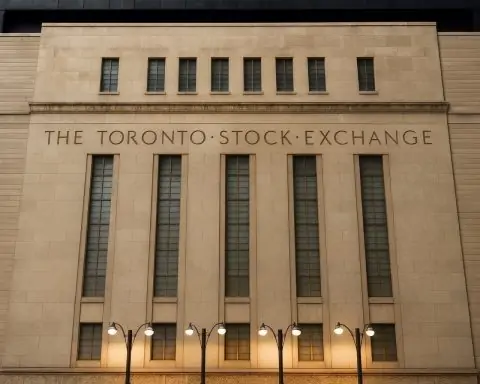- Rare Earth Pioneer: USA Rare Earth, Inc. (NASDAQ: USAR) is building a fully domestic “mine-to-magnet” supply chain for rare earth elements. It controls the Round Top rare-earth deposit in Texas and is constructing a NdFeB magnet plant in Oklahoma [1] [2] – aiming to supply critical materials for EVs, wind turbines, defense systems and more, reducing U.S. reliance on China.
- Public Debut & Ticker: USA Rare Earth went public via a SPAC merger (Inflection Point Acquisition Corp. II) in March 2025, listing on Nasdaq under ticker “USAR” [3]. The stock initially traded around $10, dipped in mid-2025, and then surged to record highs by October 2025 amid investor enthusiasm.
- Record 2025 Rally: USAR shares have skyrocketed this year – up over +120% year-to-date – and hit all-time highs in early October. The stock jumped from ~$5–6 lows to above $30 per share (5× increase) by Oct 7–9, 2025 [4]. As of Oct 9, USAR closed around the low-$30s – giving it a roughly $2.6–3.3 billion market cap – despite being pre-revenue [5].
- White House Buzz: A major catalyst was new CEO Barbara Humpton (former Siemens US CEO) revealing on Oct 3 that USAR is in “close communication” with White House officials on critical minerals [6]. This fueled speculation of federal support (investment or contracts), sparking a 15–20% one-day jump in the stock to new highs [7]. Investors are betting that government backing could significantly de-risk USAR’s ambitious projects.
- Strategic Acquisition: In late September 2025, USAR announced a $100 million acquisition of UK-based Less Common Metals (LCM) – one of the only non-Chinese producers of rare-earth magnet alloys [8]. Owning LCM gives USAR immediate rare-earth metal processing capability, fast-tracking its vertical integration. The news was cheered by the market (USAR stock popped ~30% on the announcement) as it fills a critical midstream supply gap [9] [10].
- Financials: No revenue yet. USAR is a development-stage company still building out its mine and plant. In Q2 2025 it reported a net loss of ~$142 million (due largely to one-time SPAC merger costs) and an operating loss around $8–9M [11]. It had roughly $120+ million in cash and no debt mid-2025 [12], but a big portion was spent on the LCM deal. Analysts expect USAR will seek additional funding or government grants to finance its projects [13].
- Analyst Sentiment: Wall Street views USAR optimistically for its strategic importance. Multiple analysts initiated coverage with “Buy” ratings in 2025 [14]. However, their 12-month price targets ($15–$22) now lag behind the stock’s ~$30 price after the parabolic rally [15]. At least one independent research firm has urged caution with a “Sell” rating, citing the hype outpacing fundamentals [16]. Overall, experts agree USAR’s long-term upside hinges on successful execution of its projects.
Company Background & Operations
USA Rare Earth, Inc. is a U.S.-based critical minerals company focused on establishing a fully domestic rare-earth supply chain – from mining and processing raw rare earth elements to manufacturing finished rare-earth magnets. The company’s flagship asset is the Round Top Mountain rare-earth deposit in Texas, which contains a broad range of critical rare earth elements (including heavy REEs like dysprosium and terbium) [17]. Through a joint venture (with Texas Mineral Resources), USAR controls the Round Top deposit, which is still under development but is central to securing the raw materials for its magnet production plans [18]. On the downstream side, USA Rare Earth is building a neodymium-iron-boron (NdFeB) permanent magnet manufacturing facility in Stillwater, Oklahoma [19]. Once operational (expected ~2026), this plant will produce high-performance magnets used in electric vehicle motors, wind turbine generators, defense systems, and other tech applications.
USAR’s strategy is often described as “mine-to-magnet” vertical integration. By controlling the entire value chain – mining rare earth ore, processing it into oxides, converting oxides into metals/alloys, and then manufacturing magnets – the company aims to create a domestic supply chain for critical magnet materials that is independent of Chinese supply [20] [21]. This is a strategic endeavor, as China currently produces over 90% of the world’s refined rare earths and magnets, whereas the U.S. has only one operating rare earth mine and no magnet manufacturing at scale [22]. USAR’s integrated approach could give it a cost and supply security advantage, while supporting U.S. industrial and defense needs with locally sourced materials.
Operations & Capabilities: In addition to its mining project, USA Rare Earth has acquired unique midstream capabilities through its purchase of Less Common Metals (LCM) in the UK (more on this below). LCM’s plant produces specialized rare-earth alloys – including NdPr alloy for NdFeB magnets and samarium-cobalt alloy for high-temperature magnets – and is one of the only facilities outside China that can process both light and heavy rare earths into magnet alloys [23] [24]. This gives USAR a ready-made expertise in rare-earth metal production. The company has already achieved lab-scale milestones, such as producing a sample of >99% pure dysprosium oxide from Round Top ore in 2025 [25] – demonstrating the ability to extract and refine valuable heavy REEs domestically. Going forward, USAR plans to integrate LCM’s technology into its Oklahoma magnet plant and eventually replicate LCM’s metal-processing capabilities on U.S. soil, establishing an end-to-end rare earth pipeline entirely within North America [26].
In summary, USA Rare Earth’s operations span upstream mining (Round Top deposit), midstream processing (rare earth oxide to metal/alloy conversion via LCM’s tech), and downstream manufacturing (magnet production in Oklahoma). This vertical model positions USAR as a potential first mover in resurrecting a U.S.-based rare earth industry that can supply manufacturers without reliance on Chinese materials [27] [28].
Public Trading Status and Stock Price
USA Rare Earth is a publicly traded company on the Nasdaq exchange under the ticker “USAR.” It became public through a merger with a special-purpose acquisition company (SPAC) called Inflection Point Acquisition Corp. II, which was completed on March 13, 2025 [29]. The SPAC route allowed USAR to raise capital and list on the exchange without a traditional IPO. The deal reportedly valued the company around $870 million enterprise value at the time [30]. Upon its debut, USAR stock traded near the typical SPAC baseline of ~$10 per share.
Current Stock Price (October 2025): As of October 9, 2025, USAR stock has been on a dramatic upswing, recently reaching new highs. In the first week of October, the share price surged past $30, and on Oct 9 it closed around the low-$30s after touching an intraday high above $32 [31] [32]. This marks a five-fold increase from levels around $6 per share earlier in the year. Just one week prior (late September), the stock was trading in the high-teens – underscoring how rapid and sharp the rally has been. At ~$30+ per share, USA Rare Earth’s market capitalization is roughly in the $2.5–3 billion range (depending on the exact share count) [33].
It’s important to note that USAR’s stock is fairly volatile, driven largely by news and speculative interest (since the company is not yet generating revenue or earnings). For instance, during the week of Oct 2– Oct 9, 2025, the stock saw massive daily swings: jumping +23% on Oct 2 (from ~$18.41 to $22.71) [34], then another +14% on Oct 3(to $25.96) [35], continuing to an intraday high of $30.92 on Oct 7 [36], before a brief pullback and then a further +12% surge on Oct 9. Such volatility reflects the stock’s sensitivity to announcements and sector news (discussed below).
In terms of public float and trading, USAR is a recent listing with a moderate float (the SPAC sponsors and early investors may still hold significant stakes). Daily trading volumes spiked into the tens of millions of shares during early October’s rally [37], indicating heavy interest from retail traders and possibly momentum investors. The company has an Investor Relations site and reports filings to the SEC as required, though as a newly public firm its earnings history is limited (first earnings as a public company would cover 2025).
Summary: USA Rare Earth’s stock is actively traded on Nasdaq and has experienced a steep rise to ~$30+ as of Oct 2025. This valuation reflects high investor expectations for the company’s role in the rare earth supply chain. However, the stock’s recent performance has been driven more by strategic news and future potential than by financial results, since USAR is not yet profitable. This dynamic makes the stock’s status somewhat speculative and news-dependent – something investors should keep in mind.
Recent News and Developments (Late Sept – Oct 9, 2025)
The past few weeks have been eventful for USA Rare Earth, with significant developments that have directly impacted its stock:
- New CEO Appointment (Sept 29, 2025): USA Rare Earth announced that Barbara Humpton would become the company’s Chief Executive Officer, effective Oct 1, 2025 [38] [39]. Humpton is a high-profile hire – she previously served as CEO of Siemens USA – bringing veteran leadership to USAR. She succeeded Joshua “Josh” Ballard, who had led the company through its SPAC transition. The CEO change was seen as a move to gear up for USAR’s next phase of growth. Notably, Humpton’s leadership and government connections (she has worked closely with federal initiatives in the past) added to investor excitement that USAR could strengthen its ties in Washington.
- Acquisition of Less Common Metals (announced Sept 26, 2025): In late September, USAR unveiled a “transformative” deal to acquire Less Common Metals of the U.K. for $100 million in cash plus ~6.74 million shares of USAR stock [40] [41]. LCM is renowned as a rare earth alloy producer – reportedly the only facility outside China that can produce both light and heavy rare-earth magnet alloys at scale [42]. This midstream capability is a crucial piece of the supply chain puzzle. USAR’s management touted the acquisition as “bold and transformative,” instantly giving the company know-how and capacity in rare-earth metal processing that would have otherwise taken years to build [43]. At the time of announcement, the stock portion of the deal was worth roughly another $120+ million (since USAR shares were about $18–19 then), making the total deal value around $220 million [44]. Investors reacted very positively – USAR’s stock price jumped roughly 30%in the days after the news [45]. By bringing LCM under its wing, USA Rare Earth can integrate LCM’s tech into the upcoming Oklahoma plant and even expand LCM’s existing operations (the UK site and a planned new plant in France) [46]. This development was widely viewed as accelerating USAR’s vertical integration and was likely a factor in the stock’s late-September rally.
- White House & Government Buzz (early Oct 2025): The biggest catalyst for USAR’s early October stock surge was news of the company’s engagement with the U.S. government. On Oct 3, CEO Barbara Humpton revealed in a CNBC interview that “we are in close communication with the administration” regarding USA Rare Earth [47]. This seemingly casual remark set off a firestorm of speculation on Wall Street. Investors interpreted this as a hint that USAR might be in line for some form of federal support or partnership, especially in light of recent government investments in other critical mineral companies. Within hours of Humpton’s comment, USAR’s stock soared ~18–20%, hitting a new record high intraday [48]. A Reuters report on Oct 3 noted that Wall Street was “salivating” at the prospect that USA Rare Earth could secure a deal similar to those struck with Lithium Americas and MP Materials – two companies that recently received direct government investments for strategic minerals [49]. (Just that week, the U.S. Department of Energy took a 5% equity stake in Lithium Americas, and in July the Pentagon acquired a stake in MP Materials [50], moves which sent those stocks flying.) The mere possibility that USAR could be “next in line” for government backing fueled a frenzy of buying.Context: Why does government support matter? Rare earth elements are considered critical for national defense and tech, and U.S. policymakers have been seeking to bolster domestic supply chains. Federal backing (whether via grants, contracts, or equity stakes) could provide funding and credibility to USAR, which is why even unconfirmed “White House talks” created such a buzz. As one market analyst put it, hope that USAR could be the next government investment “lit jet fuel” under the share price [51]. However, it’s important to note that as of Oct 9, no official deal or funding for USAR has been announced – the rally is based on expectation and rumor. USAR declined to comment on the speculation, and White House officials have not confirmed any investment plans [52]. This uncertainty means the stock could pull back if nothing materializes, but for now the narrative of potential federal support has become a key part of USAR’s story.
- China Export Controls News (Oct 9, 2025): In the broader rare earth industry, a major news driver on Oct 9 was China’s decision to tighten export controls on certain critical minerals. Beijing expanded its export restrictions to include more rare earth elements and impose extra licensing requirements, aiming to limit shipments to foreign defense and semiconductor companies [53] [54]. This development sent the entire rare-earth sector’s stocks upward on Oct 9. U.S. rare earth mining and processing stocks (like USAR, MP Materials, NioCorp, etc.) all rose in morning trading on the news [55]. USA Rare Earth’s share price got an extra boost of around +4–5% initially (and ended up over 12% by day’s close) as investors anticipated that stricter Chinese export curbs would increase demand for non-Chinese rare earth suppliers [56]. Analysts at Benchmark Mineral Intelligence noted, “The message is clear: If the U.S. and its allies want supply chain security, they must build independent value chains from mine to magnet.” [57] This reinforced the thesis for companies like USAR. In essence, every time China rattles its saber by restricting exports, U.S. policymakers and manufacturers become more likely to support domestic projects – a dynamic that favors USA Rare Earth’s long-term prospects.
- Other Notable Developments: In addition to the above, it’s worth mentioning that in July 2025, USAR reportedly participated in a White House roundtable on critical minerals [58], indicating it was on the government’s radar even before the recent headlines. Also, an important operational milestone occurred in mid-2025 when USAR produced its first test batch of rare earth magnets at its Oklahoma innovation lab [59], demonstrating end-to-end capability (mining a heavy rare earth like dysprosium from Round Top and turning it into a magnet). This kind of technical progress often goes under the radar amid the flashy stock news, but it’s crucial for the company’s credibility.
In summary, recent news around USAR has been overwhelmingly positive – a high-profile CEO appointment, a game-changing acquisition, signals of U.S. government interest, and favorable geopolitical tailwinds have all converged. These developments have not only driven the stock to new heights but also validated key aspects of USA Rare Earth’s strategy (e.g. the importance of an integrated supply chain and the value of having rare earth capabilities outside China).
Industry Positioning, Partnerships, and Competitive Landscape
Positioning: USA Rare Earth is positioning itself as a strategic player in the rare earths industry, specifically as a vertically integrated American supplier of rare earth magnets. In an industry long dominated by China, USAR’s emergence is timely. The U.S. government has identified rare earth supply as a national security priority, creating an environment in which a company like USAR can gain significant support. Unlike traditional mining companies that focus only on extraction, USAR’s vertically integrated model means it intends to capture value at each stage – mining, refining, alloying, and manufacturing finished products. This could make USAR a one-stop solution for customers (e.g. defense contractors, EV motor manufacturers) seeking a secure, non-Chinese source of rare earth magnets [60].
Key Assets & Advantages: USAR’s Round Top deposit is a notable asset – it’s a large polymetallic deposit containing 15 of the 17 rare earth elements (with an unusual enrichment of heavy rare earths like dysprosium, which are critical for high-temperature magnets and military applications) [61]. While Round Top is not yet producing, its development would give USAR a domestic raw material source that complements what MP Materials (Mountain Pass, California) produces. Additionally, the Stillwater, OK magnet plant (under construction) and the LCM alloy plant (in the UK, to be integrated) give USAR midstream and downstream capabilities that no other Western rare earth company currently has in-house [62]. For instance, Australian-based Lynas Rare Earths is a major producer of separated oxides but does not manufacture magnets; MP Materials produces concentrate (and is building a separation plant) but also doesn’t make finished magnets. USA Rare Earth aims to do it all under one roof, which could uniquely position it to deliver an end-product (NdFeB magnets) directly to customers. This could shorten supply chains and potentially lower costs.
Partnerships and Stakeholders: So far, USA Rare Earth’s most significant partnership was its JV with Texas Mineral Resources Corp. for the development of Round Top (Texas Mineral Resources initially owned the project and partnered with USARE in 2018–2019). As USAR moved toward going public, it effectively took the lead on Round Top’s development. Another key stakeholder is the Navajo Transitional Energy Company (NTEC) – an entity owned by the Navajo Nation – which was an early investor in USAR (participating in funding rounds) [63]. NTEC’s involvement underscores the project’s domestic strategic interest (and possibly provides an ESG angle of working with indigenous stakeholders).
On the government front, while USAR has not (as of Oct 2025) announced any federal grants or contracts, it is operating in a landscape where public-private collaboration is increasing. The Department of Defense and Department of Energyhave given financial support to other rare earth projects (e.g., DoD grants to Lynas and MP, DOE’s recent stake in Lithium Americas). USAR’s engagement with officials (e.g., the White House critical minerals meeting in July) suggests it is in the mix for future support [64]. Should any formal partnership or offtake agreement with a U.S. government agency or defense contractor emerge, it would further solidify USAR’s position.
Competitive Landscape: In North America, USAR’s peers include MP Materials (NYSE: MP) – which operates the Mountain Pass mine (the only currently active US rare earth mine) and is building processing facilities. MP is ahead in mining (already producing concentrate) and has a long-term supply agreement with General Motors for magnets, but it still ships material to China for final processing as of 2025. Energy Fuels and NioCorp are other North American players focusing on certain critical minerals (Energy Fuels processes some rare earth carbonate, NioCorp is developing a niobium-REE project), but these companies have narrower scopes. Lynas Rare Earths (Australia) is a big non-Chinese producer (with processing in Malaysia), and Neo Performance Materials (Canada) produces some magnetic materials and magnets in Estonia and Thailand. However, none of these competitors currently encompass the full vertical rangethat USA Rare Earth is pursuing [65]. This means USAR could become the first fully integrated rare earth-to-magnet supplier in the Western hemisphere [66].
That said, being a first mover comes with execution risk – USAR has to prove it can actually bring Round Top into production, ramp up the Oklahoma facility, and integrate LCM effectively. Competitors may also seek partnerships; for example, MP Materials might partner with an alloy maker or magnet producer to replicate some vertical integration, and Lynas has talked about moving into magnet manufacturing as well. It’s also possible that USAR might collaborate with some peers – for instance, it could supply refined oxides or metals to others, or even source feedstock from other mines if Round Top is delayed. The rare earth sector is relatively small outside China, so companies have sometimes cooperated (Neo Performance, for example, buys material from Lynas). USAR’s LCM acquisition even gives it a presence in Europe – potentially serving European magnet consumers and aligning with allied supply chain initiatives, which is a competitive plus.
In summary, USA Rare Earth’s industry position is one of a potential “supply chain solution” provider, aligning well with U.S. policy goals. Its holistic approach sets it apart from competitors, though those competitors often have more established operations in at least one segment of the chain. If USAR executes successfully, it could become a linchpin supplier for domestic industries (EV, aerospace, defense) that need rare earth magnets and want to avoid supply disruptions. This strategic value is a big reason why the company garners attention beyond its current financials.
Financial Health and Investment Outlook
As of 2025, USA Rare Earth is in a pre-revenue, investment phase – meaning it has no significant sales yet, while expenses are ramping up to build its operations. This is typical for companies developing mines and new production facilities, but it requires investors to be patient and focus on future potential rather than present earnings.
Balance Sheet & Cash: Upon completing its SPAC merger in early 2025, USAR received funds to support its projects. Mid-year 2025 filings showed around $120–128 million in cash on hand and zero debt on the balance sheet [67]. This cash was earmarked for construction of the Oklahoma magnet plant, advancing Round Top’s design, and general corporate needs. However, the $100M cash acquisition of LCM in late September represents a significant outlay – likely funded from that cash reserve (plus stock issuance). After the LCM deal, USAR’s cash position would be substantially lower, perhaps necessitating additional fundraising in the near future. The company has indicated that net proceeds from the SPAC and subsequent PIPE investments were to be used for these expansion efforts [68], including the Stillwater magnet facility and Round Top development.
Expenses and Losses: In Q2 2025 (its first quarter as a public entity), USA Rare Earth reported a net loss of approximately $142 million [69]. It’s important to note that a large portion of this was attributed to one-time transaction costs related to the SPAC merger (such as share-based accounting adjustments). Excluding those, the adjusted operating loss was around $8–9 million for the quarter [70], reflecting R&D, salaries, and overhead – a more reasonable figure that hints at the ongoing “cash burn” rate. We can extrapolate that annualized, USAR might be spending tens of millions per year on development before revenue kicks in. With the current cash (post-acquisition) and assuming no revenue in 2025, the company would likely need additional capital within a year or so to keep its ambitious projects on track.
Funding Outlook: How will USAR bridge the funding gap? Management has a few avenues:
- Equity Raises: With the stock price surging in late 2025, USAR could issue new shares to raise cash relatively efficiently. Its 2025 rally provides an opportunity to raise money at higher valuations (less dilution for existing shareholders) [71]. The company has already demonstrated access to capital markets – it went public via SPAC and secured PIPE investments (private investment in public equity) of over $40 million as part of that deal [72] [73]. Given the positive momentum, a secondary stock offering is a possibility in 2026 to fund construction and ramp-up.
- Government Grants/Loans: The U.S. government has various funding programs for critical materials (e.g. Department of Defense technology investment agreements, Department of Energy loans or grants). Rival MP Materials, for example, received Department of Defense funding for a magnet facility, and Lynas received Pentagon funding for a processing plant. USAR could benefit from similar support, especially if policy makers want to ensure its projects succeed. Any such funding (either direct investment or loans) would improve USAR’s financial position and reduce the need to tap capital markets [74] [75].
- Joint Ventures or Strategic Investors: USAR might also consider bringing in strategic partners – for instance, an automaker, wind turbine manufacturer, or defense contractor that needs magnets might invest in USAR or pre-pay for future production. Another possibility is partnering with companies that have complementary capabilities (though USAR now covers most of the chain, a partner might help with distribution or technology). The Navajo Transitional Energy Co. investment is an example of a strategic stakeholder; others could emerge as the projects near fruition.
Outlook for Revenue and Profitability: USA Rare Earth is targeting initial commercial production roughly by 2026(likely starting with the magnet plant). If Round Top mine development stays on track, mining could start around 2026-2027. Until those come online, revenue will remain minimal (perhaps only pilot project revenues or grants). Analysts expect that 2026–2027 will be the inflection point where USAR could start generating revenue from magnet sales or material sales. Profitability would be further out – possibly late this decade – after scaling up and achieving efficient operations.
Given these timelines, investors should expect ongoing losses in the next few quarters. This is normal for a startup-like venture in a capital-intensive industry: USAR is spending now to build facilities that should yield cash flow later (“invest now, reap revenue later”). The market, as evidenced by the stock’s rise, is valuing the future potential more than current earnings. But this also means the stock price could be volatile if there are delays or cost overruns. For example, if construction of the magnet plant hits snags or if Round Top’s permitting takes longer than expected, it might dampen investor enthusiasm.
Investment Considerations: From an investment perspective, USA Rare Earth is a high-risk, high-reward scenario. On one hand, it stands at the nexus of several powerful trends: electrification (EVs need magnets), geopolitical supply chain shifts, and government backing of critical minerals. If it executes well, it could capture significant market share in a growing field (the rare earth magnet market is projected to expand as EV and defense demand rises). Bulls argue that USAR’s vertically integrated approach could yield strong margins once fully operational, since the company won’t have to buy expensive refined materials from third parties [76]. Additionally, if the U.S. government continues to intervene (via offtake agreements or investments), that could de-risk the company and potentially boost shareholder value (as seen with recent federal stakes in peers).
On the other hand, USAR is essentially a bet on successful execution and supportive policy. The company must coordinate mining (which has its own technical and environmental challenges) with processing and manufacturing – any one of which could face hurdles. Until revenues kick in, USAR will be consuming cash, so dilution or debt is a possibility down the road (if market conditions sour, raising money could become harder). Furthermore, the current stock price already factors in a lot of good news. If, for instance, the hoped-for government partnership doesn’t happen soon, the stock might retreat from its highs as short-term traders take profits. Some analysts have cautioned that the recent rally is “tempered by uncertainty” until an actual government deal materializes [77].
In summary, USA Rare Earth’s financial health is that of an early-stage growth company – well-funded after its IPO but facing heavy investment needs. It will likely need additional capital to reach the finish line. Investors optimistic about the critical need for rare earth independence see USAR as a pivotal long-term play (and are less concerned about near-term losses), whereas more cautious observers note that the company’s valuation appears rich relative to its still-nascent operations. The next 1-2 years will be crucial in determining if USAR can transition from a cash-burning developer into an operational revenue-generating enterprise as envisioned.
Stock Performance Trends and Forecast
USA Rare Earth’s stock (USAR) has exhibited extraordinary performance in 2025, coupled with high volatility. Here’s a closer look at its trends and what analysts forecast:
2025 Performance Snapshot: After going public in March 2025 around $10, USAR shares traded in a relatively modest range for a few months (typical for many SPAC-merger stocks, some even dipped below the initial value). By mid-2025, the stock was reportedly as low as the mid-single digits (around $5–6 at the trough) [78], reflecting earlier investor caution. However, starting late Q3 2025, momentum shifted dramatically. Key news in late September and early October (the LCM acquisition, leadership change, White House communications) unleashed a massive rally. From roughly $15–18 in mid-late September, USAR rocketed to an intraday peak of ~$28 by Oct 3, then continued to hit new highs above $30 in the following week [79].
To put this in context, in the first week of October alone the stock climbed about 70% (from ~$18 on Oct 1 to over $30 by Oct 7). Year-to-date, by early October, USAR was up over +120% [80] (and much more from its lows). Such rapid appreciation indicates a surge of speculative buying and strong sentiment around the company’s prospects.
Volatility: Alongside the upward trend, there have been sharp swings. For example, intraday moves of 10–20% became common in early October. The stock’s beta (volatility relative to the market) is likely very high given its short trading history. External news (like China’s export announcements or government remarks) can cause abrupt spikes or dips. This means traders in USAR need to be prepared for large short-term moves. The stock’s volume and volatility also suggest presence of momentum traders and possibly short-sellers trying to bet on a pullback. Indeed, after hitting about $32, it would not be surprising to see some profit-taking in the absence of fresh news.
Comparative Sector Performance: Rare earth and strategic mineral stocks broadly have been on an upswing in 2025, partly due to geopolitical factors. For instance, the VanEck Rare Earth/Strategic Metals ETF (REMX) was up ~91% year-to-date by early October [81]. USAR, despite being a newcomer, outpaced even that. Another peer, MP Materials (MP), saw its stock rise significantly when the Pentagon investment news hit. This sector-wide rally provides some validation – it’s not just USAR in isolation, but a broader trend of investors piling into domestic critical mineral plays. However, USAR’s gains have been among the most extreme, which suggests company-specific drivers (i.e., its own news) amplified the general rare-earth boom.
Analyst Targets & Forecasts: Professional equity analysts initiated coverage on USAR after it went public. The consensus outlook has been optimistic in the long run, but many analysts issued price targets that, in hindsight, appear conservative relative to the current price. For example, Canaccord Genuity launched coverage with a $22 price target (Buy) and Cantor Fitzgerald with a $16 target (Overweight) [82]. These targets were likely set before the latest run-up and assumed more gradual progress. Now that the stock has overshot those levels (> $30), analysts may revise their models. It’s worth noting that USAR’s value is tricky to forecast via traditional metrics (since there are no earnings or even revenues yet). Instead, analysts often use discounted cash flow projections based on expected future production and government support scenarios, which carry a lot of uncertainty.
Some market commentators have actually suggested the stock got ahead of itself. A MarketBeat editorial on Oct 7 pointed out the speculative spike might make it a good time for short-term traders to “lock in gains”, given that much of the rally is anticipation-based [83]. Similarly, The Motley Fool highlighted that while US-China tensions provide a bullish long-term backdrop for USAR, the short-term might be choppy or “worrying” due to the company’s need to deliver on promises [84]. In other words, there could be pullbacks if the hype isn’t met with concrete developments soon.
On the flip side, long-term forecasts for USAR (among bullish analysts) envision the company eventually generating hundreds of millions in annual revenue from magnet sales, which could (if successful) justify a stock price higher than today’s. But that may be years out. In the interim, forecasts for the next 6-12 months vary widely. We’ve seen algorithmic predictions (from lesser-known outlets) suggesting USAR might settle in the mid-$20s in the coming weeks [85] – implying a possible pullback from current highs – though such predictions should be taken with a grain of salt.
Many analysts are likely to adopt a “wait-and-see” stance: maintain bullish ratings due to the strategic story, but not raise price targets until there’s clarity on government deals or project milestones. One thing most agree on is that news flow will drive the stock. Positive surprises (e.g. an early Pentagon contract, or faster project progress) could propel another leg up. Negative surprises or delays could trigger sharp declines.
Investor Sentiment: Retail investor forums and media coverage indicate USAR has captured interest as a story stock – it’s seen as a way to invest in American resource independence and the EV/cleantech supply chain theme. This narrative-driven interest can cause overshooting in the short term. Importantly, Jim Cramer – a well-known market commentator – recently discussed USAR during his lightning round, acknowledging that “you’re not playing the earnings… there aren’t any” but that the White House speculation means “You can play that” kind of stock [86]. His point underscores the current dynamic: the stock is trading on momentum and potential. Cramer’s take was that USAR fits the pattern of speculative critical-minerals stocks that could get a government stake at any moment, so he wouldn’t oppose someone owning it for that upside – as long as they understand it’s a speculative play [87].
Looking Ahead: The stock’s trajectory will likely hinge on a few key upcoming events:
- Project Updates: Any news on the magnet plant completion or the Round Top mining timeline could move the stock. If USAR announces that it has produced its first magnets (even at pilot scale) or signs its first supply agreement with a customer, that would be positive.
- Earnings Reports: Although financials are minimal now, quarterly reports can still sway sentiment. Investors will watch the cash burn rate, any changes in guidance, or hints at partnerships in management commentary.
- Government Policy/Contracts: This is the big wildcard. Continued U.S. government emphasis on critical minerals (e.g. through legislation or funding) will generally support the stock. Conversely, if geopolitical tensions unexpectedly ease (reducing urgency for domestic supply chains), related stocks could cool off – though such an easing seems unlikely in the current climate.
- Macro Factors: Demand for EVs and clean tech (which drives magnet demand) is a macro factor. Also, interest rates and liquidity conditions can affect speculative stocks – a rising rate environment can dampen enthusiasm for pre-profit companies, whereas a friendly Fed can do the opposite.
In summary, USAR’s stock trend has been strongly upward in 2025, but with high volatility. Forecasting the precise stock price is difficult given the speculative elements, but many experts believe the long-term trend could remain positive if the company hits its milestones and if external support comes through. Still, after such a steep rally, a period of consolidation or correction could be healthy. Prospective investors should be prepared for a bumpy ride and keep an eye on the fundamental progress that underpins the lofty valuation.
Expert Quotes and Analysis
Industry experts, analysts, and media commentators have weighed in on USA Rare Earth’s prospects. Here are some notable insights:
- Jim Cramer (CNBC) – “We said that [rare earth companies] are all speculative, but we recognize that the president, at any given moment, could take a stake… I am going to say that [USAR] fits that pattern… There’s White House talk… You can play that. Remember, you’re not playing the earnings… you know there aren’t any.” [88] – Cramer emphasized that USAR is a speculation on government action rather than fundamentals (since it has no earnings yet). He doesn’t discourage owning it, but frames it as a trade on possible White House support. This underscores both the upside and risk: the stock can skyrocket on policy news, but it’s not underpinned by current profits.
- Benchmark Minerals Intelligence – “If the U.S. and its allies want supply chain security, they must build independent value chains from mine to magnet… [This] presents a window of opportunity for emerging producers and processors outside China to position themselves as credible alternatives.” [89] [90] – Analyst Neha Mukherjee’s comment (after China’s export curb news) highlights the strategic context benefiting USAR. It suggests that companies like USA Rare Earth have an opening to fill the non-Chinese supply gap, and likely will see increased investment and support as a result.
- Subash Chandra (Benchmark Company analyst) – “Any reshoring strategy should include [USA Rare Earth].” [91] – This quote, cited in a Reuters piece, reflects the view of some Wall Street analysts that USAR is a linchpin in America’s effort to re-establish a domestic rare earth supply chain. It implies that experts believe USAR is exactly the type of company the U.S. government and industry want to succeed, bolstering the investment thesis that support will eventually materialize.
- MarketBeat Editorial – “[The] speculative spike might be the right time to sell… tempered by uncertainty until something official materializes.” [92] – A more cautious take, this commentary warned short-term traders that USAR’s huge rally is built on anticipation of a government deal that hasn’t happened yet. It advises that unless one is confident an announcement is imminent, there’s risk of a pullback. This balanced view is a reminder of the uncertainty in the stock – great story, but needing confirmation.
- The Motley Fool – “China’s trade war with the U.S. is long-term good news for USA Rare Earth stock. It’s the short term that’s worrying.” [93] – This analysis encapsulated the bull vs. bear scenario: the structural trend (de-globalization of supply chains, U.S.-China decoupling) undoubtedly favors USAR’s mission, but in the immediate term the company faces hurdles (like funding, execution, and potential Chinese retaliation affecting global supply chains) that make the journey volatile. Essentially, long-term tailwinds, short-term turbulence.
- Company Leadership – USAR’s own statements have been optimistic. Upon acquiring LCM, the company said it “represents a significant acceleration of our mine-to-magnet strategy.” [94] And Chairman Michael Blitzernoted that once LCM’s know-how is transplanted, it will establish rare-earth metal production on U.S. soil “that hasn’t existed in decades” [95]. This speaks to the historical significance – the U.S. has not had a full rare earth metals and magnets supply chain domestically for a very long time, and USAR aims to change that.
- Sector Analysts – Broadly, analysts covering the critical minerals sector often mention USAR alongside MP Materials and Lynas as leading names in the Western rare earth resurgence. A Bloomberg piece pointed out that U.S. rare earth stocks jumped on hopes of continued government purchasing, especially after news of federal stakes in companies in 2025 [96]. USA Rare Earth, in these discussions, is frequently cited as a beneficiary of policy momentum (e.g., defense spending bills that include funds for strategic materials).
In conclusion, expert opinion on USA Rare Earth combines excitement about its strategic role with caution about its speculative nature. The company is widely seen as critical for U.S. supply chain goals – a view that lends credibility to its mission and likely implies ongoing support from policymakers and investors. However, seasoned voices remind us that until USAR delivers tangible results (production, revenue) or locks in concrete backing, the stock’s lofty valuation is riding on future promises. Investors would do well to heed both the optimism and the caveats: USA Rare Earth is at the forefront of a potentially game-changing industry shift, but the path to fulfilling that promise is still under construction.
Sources:
- Tech Space 2.0 – “USA Rare Earth Stock Skyrockets on Rare Earth Boom and White House Buzz – What’s Driving USAR’s Record High?” (Oct 7, 2025) [97] [98] [99] [100] [101]
- Reuters – coverage of China’s export controls and market reaction (Oct 9, 2025) [102] [103]; Reuters (Feb 2021) on USARE’s IPO plans [104] [105].
- Company Press & IR: Nasdaq/GlobeNewswire press release (Feb 4, 2025) on SPAC merger and PIPE funding [106] [107]; ForgeGlobal IPO summary [108]; RawMaterials.net on LCM acquisition details [109] [110].
- Yahoo Finance/Insider Monkey: Cramer’s comments on USAR (Oct 9, 2025) [111].
- MarketBeat & Motley Fool: Analyses of USAR stock performance and outlook [112] [113].
- Bloomberg & Others: Sector analysis highlighting USAR [114] [115]. (Additional links: Yahoo Finance, Seeking Alpha, and company website for background.)
References
1. ts2.tech, 2. www.nasdaq.com, 3. forgeglobal.com, 4. ts2.tech, 5. ts2.tech, 6. ts2.tech, 7. ts2.tech, 8. ts2.tech, 9. ts2.tech, 10. rawmaterials.net, 11. ts2.tech, 12. ts2.tech, 13. ts2.tech, 14. ts2.tech, 15. ts2.tech, 16. ts2.tech, 17. ts2.tech, 18. ts2.tech, 19. www.nasdaq.com, 20. www.reuters.com, 21. www.nasdaq.com, 22. www.reuters.com, 23. rawmaterials.net, 24. ts2.tech, 25. rawmaterials.net, 26. ts2.tech, 27. www.nasdaq.com, 28. www.reuters.com, 29. forgeglobal.com, 30. tmrcorp.com, 31. finance.yahoo.com, 32. stockanalysis.com, 33. ts2.tech, 34. stockanalysis.com, 35. stockanalysis.com, 36. stockanalysis.com, 37. stockanalysis.com, 38. www.govconwire.com, 39. simplywall.st, 40. ts2.tech, 41. rawmaterials.net, 42. rawmaterials.net, 43. ts2.tech, 44. ts2.tech, 45. ts2.tech, 46. rawmaterials.net, 47. ts2.tech, 48. ts2.tech, 49. ts2.tech, 50. ts2.tech, 51. ts2.tech, 52. ts2.tech, 53. www.reuters.com, 54. www.reuters.com, 55. www.reuters.com, 56. www.reuters.com, 57. www.reuters.com, 58. ts2.tech, 59. www.nasdaq.com, 60. www.reuters.com, 61. ts2.tech, 62. ts2.tech, 63. forgeglobal.com, 64. ts2.tech, 65. ts2.tech, 66. www.nasdaq.com, 67. ts2.tech, 68. www.nasdaq.com, 69. ts2.tech, 70. ts2.tech, 71. ts2.tech, 72. www.nasdaq.com, 73. www.nasdaq.com, 74. ts2.tech, 75. www.reuters.com, 76. ts2.tech, 77. ts2.tech, 78. ts2.tech, 79. ts2.tech, 80. ts2.tech, 81. www.reuters.com, 82. ts2.tech, 83. ts2.tech, 84. finance.yahoo.com, 85. www.wallstreetzen.com, 86. www.insidermonkey.com, 87. www.insidermonkey.com, 88. www.insidermonkey.com, 89. www.reuters.com, 90. www.reuters.com, 91. ts2.tech, 92. ts2.tech, 93. finance.yahoo.com, 94. ts2.tech, 95. ts2.tech, 96. www.bloomberg.com, 97. ts2.tech, 98. ts2.tech, 99. ts2.tech, 100. ts2.tech, 101. ts2.tech, 102. www.reuters.com, 103. www.reuters.com, 104. www.reuters.com, 105. www.reuters.com, 106. www.nasdaq.com, 107. www.nasdaq.com, 108. forgeglobal.com, 109. rawmaterials.net, 110. rawmaterials.net, 111. www.insidermonkey.com, 112. ts2.tech, 113. finance.yahoo.com, 114. www.reuters.com, 115. www.bloomberg.com







